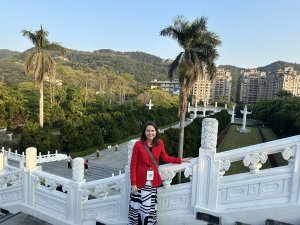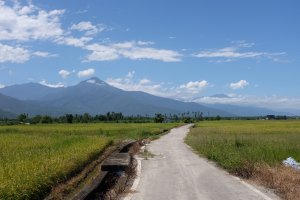During my 2016–17 Fulbright fellowship in Taiwan, I had the opportunity to visit the Taoyuan factory of Sheng Kuang 聖光 (Sacred Radiance), a leading manufacturer of Buddhist statuary whose finished work can be found in temples and sacred sites across Taiwan and other parts of Asia. While the company produces Buddhist images of every size, some of their statues are remarkably large, including the Ushiku Daibutsu 牛久大仏 in Japan, which at 390 feet is (as of this writing) the third-tallest statue in the world. They have also produced large-scale statues for temples in Taiwan, such as the 236-foot tall image of the Buddha Maitreya at the Tian’en Maitreya Buddha Temple 天恩彌勒佛院in Hsinchu. Visiting their factory offered an amazing chance to witness firsthand how these statues are produced, and to better understand how new technologies are changing the manufacture of Buddhist statues.
Scholars of Buddhism know that images and icons have been fundamental to Buddhism’s historical spread across Asia since its emergence in roughly the 5th century BCE, and statues of the Buddha Śākyamuni, bodhisattvas, and other figures have always featured prominently on the altars of Buddhist temples and played an important role in the everyday religious lives of Buddhists. Pre-modern Buddhists were no stranger to large-scale bronze statuary, either, as we can see from the famous Nara Daibutsu 奈良大仏 (752 CE) and Kamakura Daibutsu 鎌倉大仏 (1252 CE) statues produced in early and medieval Japan. Sheng Kuang’s bronze statues thus stand in a tradition of Buddhist sacred image-making that is over a thousand years old. At the same time, Sheng Kuang is also at the center of a technological revolution that is transforming the millennia-old processes by which statues are produced.
Traditionally, clay sculptures of equal scale had to provide the prototype for the casting of bronze sculptures. In order to see how recent developments in 3D modeling and 3D printing technologies are changing the process, let us consider several stages in the manufacturing of the Tian’en Maitreya statue. First, the sculptor created a model out of clay, slightly larger than a human, and prepared it for 3D scanning by applying dots all over its surface to serve as reference markers (Figure 1). Then the clay statue was scanned into the computer as a 3D model, which could be cut into a Styrofoam figure at any scale. The full-sized Styrofoam figure was produced in multiple separate pieces (Figure 2). After the surface was further refined, these Styrofoam pieces were used to make the molds for each piece of the statue, which were then cast in bronze. Finally, the site was prepared at Tian’en Temple, scaffolding was erected, the bronze pieces were transported to the site and the image was assembled piece by piece (Figure 3) until its surface was finished to make the seams between the pieces invisible (Figure 4).
Figure 1. Clay image of the Buddha Maitreya, roughly 7 feet in height. Photograph by the author.
Figure 2. Large-scale Styrofoam version of the Buddha Maitreya. Photograph from Sheng Kuang website.
Figure 3. Stages of building the bronze Maitreya statue at Tian’en Temple. Photograph from Sheng Kuang website.
Figure 4. Finished Maitreya statue standing over Tian’en Temple. Photograph from YouTube.
Sheng Kuang uses a powerful combination of traditional sculpting techniques and emerging computer technologies. This enables the relatively easy scaling up of images originally sculpted by hand at a normal human scale and eliminates some of the most difficult aspects of manufacturing large bronze statues. Styrofoam cut by machine to match the contours of 3D computer models is also used for the production of smaller-scale bronze images. Figure 5 shows a craftsperson working on the surface of a Styrofoam image that will end up as a bronze statue of roughly human height in a seated posture. If we look closely at the photograph, we can see that even this smaller image has been produced out of several constituent parts, with tape on the surface of the image showing how head, torso, and legs are separate pieces. The right arm also has not yet been attached. Once the surface details have been finalized, it too will be taken apart and cast as several pieces, which will then be reassembled into the final statue. Other small-scale fiberglass images, on the other hand, are instead 3D-printed directly from a computer model.
Figure 5. Craftsperson finishing surface of Styrofoam Buddhist statue, which has been assembled from multiple parts. Photograph by the author.
Most of Sheng Kuang’s images, like the Tian’en Maitreya, are produced for Buddhists in Taiwan and are designed to reflect longstanding Chinese Buddhist visual conventions. At the same time, the Ushiku Daibutsu and other statues produced for clients in Japan were designed in the Japanese style. Most recently Sheng Kuang produced an image for clients in Sri Lanka, and there too they designed the statue in accordance with Sri Lankan Buddhist stylistic conventions. The designers at Sheng Kuang thus demonstrate a broad repertoire of stylistic possibilities for their Buddhist statuary, flexibly adapting to the specific visual customs and preferences of clients from various Buddhist traditions.
Sheng Kuang has two main factory buildings, the first of which is used for work on smaller-scale statues. The second factory building, by contrast, is much larger and has ceilings high enough to hold very large-scale statues as they are being brought to completion. As I walked into this second, larger factory building, I encountered an array of images in Styrofoam, clay, bronze, and fiberglass (Figure 7). Although in the course of a single visit I was unable to see any particular image progress from inception to completion, there were so many different images on the factory floor in various states of progress that I could gain an understanding of each work’s trajectory. Especially remarkable was the experience of standing next to various Styrofoam pieces of what was to become another large-scale bronze image, this one of the Bodhisattva Guanyin 觀音, the “Hearer of the World’s Sounds” known from the Lotus Sūtra for offering help to anyone in need. Guanyin’s attire and posture are rendered particular intricately, with elaborately flowing robes (Figure 8) and a great deal of ornamentation (Figure 9).
Figure 6. First Sheng Kuang factory building from outside. Photograph by the author.
Figure 7. Inside of second Sheng Kuang factory building. Photograph by the author.
Figure 8. Portions of large-scale Styrofoam image of the Bodhisattva Guanyin, with flowing robes.
Figure 9. Portions of large-scale Styrofoam image of the Bodhisattva Guanyin, with ornamented crown.
Standing up close to and photographing the Styrofoam images that would be used to cast the bronze, I could see where distinct pieces had been stitched together with metal wires for the purposes of preliminary partial assembly and finishing the surface (Figure 10). Now, as I look at the photographs several months later, I find that the perfectly straight lines cutting across the statue’s dynamic contours seem to visually encapsulate the combination of artistry and precision required for Sheng Kuang’s enterprise. Using these two skill sets in tandem, they are carrying forward a long tradition of Buddhist statuary manufacture, even as they innovate.
Figure 10. Portions of large-scale Styrofoam image of the Bodhisattva Guanyin, with visible connections between separately manufactured parts.
I am grateful to Fulbright Taiwan for making this year of research possible, and to Sheng Kuang for allowing me to tour their facilities. As a specialist in the history of Chinese Buddhism, it was an eye-opening experience that has helped me to acquire a better understand Buddhism’s past as well as its future.




